There are fourteen venomous species of snake in California. Ten of the fourteen are rattlesnakes. California has four venomous colubrid snake species. These are not as dangerous as the other ten.
All fourteen snakes are listed below. In this article, we will examine each one in depth. We’ll also go over where they live within the state of California.
Rattlesnakes
- Colorado Desert Sidewinder (Crotalus cerastes laterorepens)
- Mojave Desert Sidewinder(Crotalus cerastes cerastes)
- Great Basin Rattlesnake(Crotalus lutosus)
- Northern Pacific Rattlesnake(Crotalus oreganus)
- Mojave Rattlesnake (Crotalus scutulatus)
- Southwestern Speckled Rattlesnake(Crotalus pyrrhus)
- Panamint Rattlesnake(Crotalus mitchelli stephensi)
- Red Diamond Rattlesnake(Crotalus ruber)
- Southern Pacific Rattlesnake(Crotalus helleri)
- Western Diamondback Rattlesnake(Crotalus atrox)
Rear-Fanged Colubrid Snakes
- Western Shovel-nosed Snake (Sonora occipitalis)
- Sonoran Lyre Snake (Trimorphodon lambda)
- Night Snake (Hypsiglena torquata)
- Southwestern Blackhead Snake (Tantilla hobartsmithi)
Rattlesnakes in California
Rattlesnakes belong to the venomous viperidae or pit viper family. Pit vipers have heat-sensing pits between their nostrils and eyes. These pits are actually specialized organs that detect infrared radiation from prey animals. Pit organs enable pit vipers to strike their prey precisely, even in the dark. They are also able to detect body heat from about 1 meter away.
Pit vipers have hollow fangs connected to venom glands. They use their fangs to inject venom into their prey. This venom immobilizes the prey, making it easier for the snake to consume. They primarily consume small mammals, reptiles, amphibians, and small birds. They play an important role in maintaining balance in rodent populations.
The first thing people think about in relation to rattlesnakes is their tails. When they are disturbed, they vibrate the rattles on their tails. This makes a buzzing or a rattling-type sound. Beware though. Sometimes, rattlers strike without rattling. Sometimes, their rattles fall off. You must be aware of where you are placing your hands and feet when you’re in rattlesnake country. If you hear a rattling noise, don’t move until you spot where it originated. Otherwise, you may accidentally move into the snake, prompting it to strike you.
The gopher snake and the California kingsnake both coexist with rattlesnakes. Gopher snakes have a color pattern that closely mimics that of a rattlesnake. They are nonvenomous, though. They compete with rattlesnakes for the same prey animals.
California kingsnakes also compete with rattlesnakes for prey. Like gopher snakes, they are constrictors. Their menu includes a variety of snakes, including rattlesnakes. Lucky for them, they are immune to rattlesnake venom.

Sidewinder Rattlesnake
The Sidewinder Rattlesnake is found in the southwestern United States and northwestern Mexico. In California, they are found in the southwestern part of the state.
The sidewinder’s defining characteristic is its mode of travel. These snakes get their name from their peculiar sideways form of locomotion. They lead with their midsections instead of their heads. It turns out that this is a much more effective way to move across the sandy desert areas. They are fast-moving snakes and can reach speeds of up to 18 mph.
The adult snake measures 17 to 31 inches in length, with the female being the largest. Their base color pattern varies from cream, buff, yellowish-brown, pink, or ash gray. It is overlaid with 28-47 dorsal blotches. The belly is white, and the adult’s proximal lobe’s rattle is brown. Sidewinders are unique in that they can change their coloration. Other species, such as chameleons and Arizona Black rattlesnakes, share this ability. The process of doing this is metachrosis.
The Sidewinder Rattlesnake is venomous, but its venom is weaker than other rattlesnakes. They also have smaller-sized venom glands. This makes them less dangerous than their larger relatives. You should still be wary of them, though. Any rattlesnake bite can be fatal. Furthermore, medical attention should be sought immediately if bitten.
There are two subspecies of sidewinder rattlesnakes in California:
- Mojave Desert Sidewinder– has a black tip on its rattle
- Colorado Desert Sidewinder– has a brown tip on its rattle
How Dangerous Are Sidewinders?
The Sidewinder Rattlesnake is venomous, but its venom is weaker than other rattlesnakes. Their smaller venom glands make them less dangerous than their larger relatives. You should still be wary of them because any rattlesnake bite can be fatal. If bitten, you should seek medical attention immediately.
Sidewinders can’t inject enough venom in one bite to create severe complications. However, it’s more serious if the victim gets envenomated multiple times. If medical treatment is delayed, the following complications could occur.
- Internal bleeding
- Deep tissue damage may lead to bacterial infections and gangrene.
- Loss of use of the affected limb
- Severe shock
- Paralysis
- Seizures
- Coma
- Multiple organ failure source
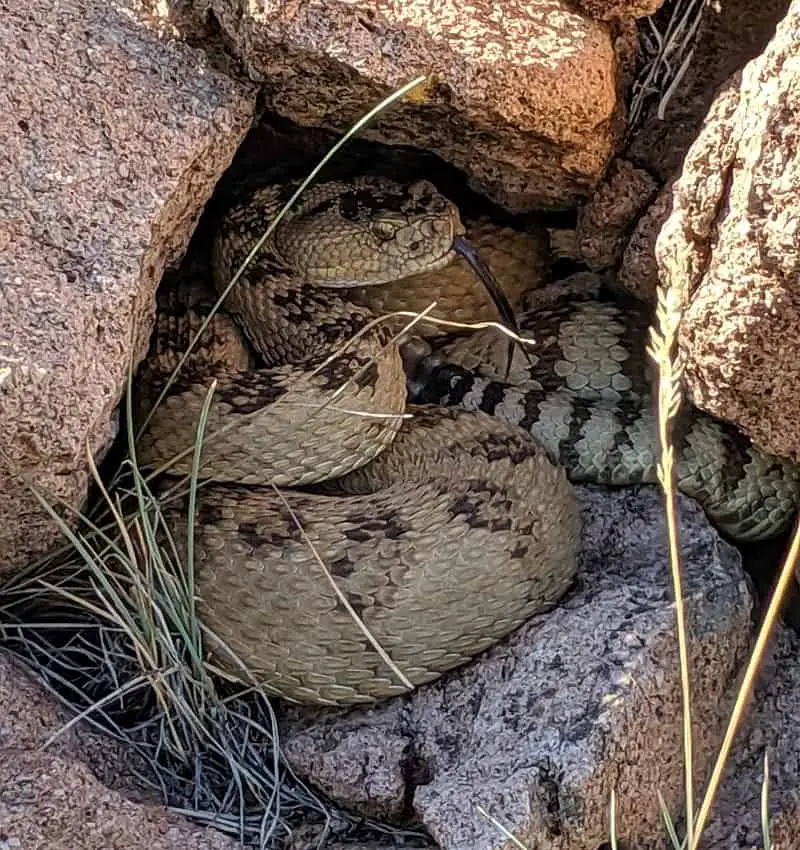
Great Basin Rattlesnake (Crotalus o. lutosus)
The Great Basin Rattlesnake is a subspecies of the Western Rattlesnake. See,
These snakes’ bodies are light grey or light brown. Their bodies are also covered with dark blotches. These blotches are dark brown to black with pale centers. These rattlesnakes rarely exceed 3 feet (.91 m) in length. However, the largest specimens grow to 4 feet (1.22 m).
Where Do Great Basin Rattlesnakes Live in California?
Great basin rattlesnakes have a variety of habitats in which they can live and survive. These include juniper forests, sagebrush flats, and rocky outcrops. This rattlesnake’s range takes in parts of northeast California.
How Dangerous Are Great Basin Rattlesnakes?
Great Basin rattlesnake venom is a potent mix of myotoxins and hemotoxins. Their bites may produce pain, edema, nausea, and vomiting. Furthermore, the hemotoxic part of their venom can cause internal bleeding. This may lead to multiple organ damage. Moreover, the myotoxic part of their venom will produce necrosis of body tissue. Source
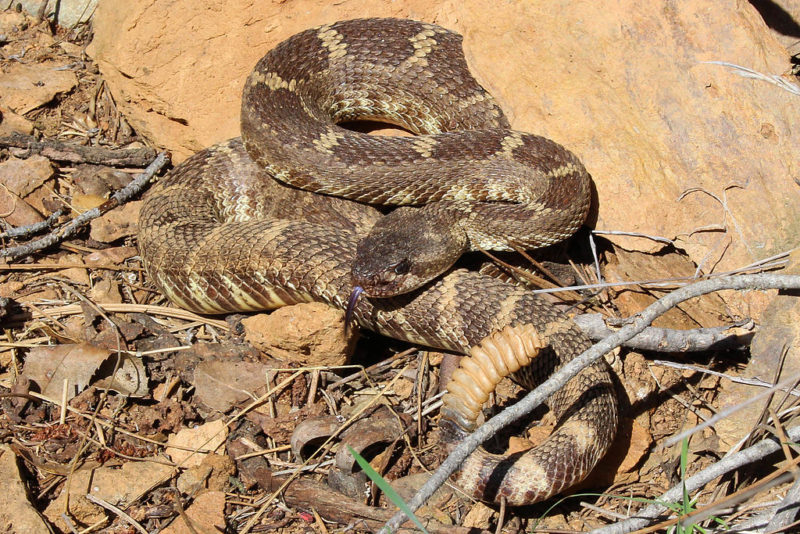
Northern Pacific Rattlesnake (Crotalus oreganus)
Another name for the Northern Pacific rattlesnake is the Western rattlesnake.
These snakes can grow to 39 inches (99cm) long. The longest Northern Pacific rattlesnake on record is 64 inches. Their base color varies. They are dark brown, dark gray, and sometimes black. Their base color is interspersed, with a covering of dark blotches with lighter edges. These blotches turn into crossbands at the tail. The last two crossbands at the end of their tail are generally black. Their bellies are pale yellow with brown spots. There is a dark brown stripe with a light border extending from its eye through the angle of the jaw.
Where Do Northern Pacific Rattlesnakes Live in California?
The Northern Pacific is the most common rattlesnake in California. They range from Santa Barbara County east to the Sierras. Their range also extends north through coastal Northern California.
How Dangerous Are Northern Pacific Rattlesnakes?
Northern Pacific rattlesnake venom is a mix of neurotoxins, hemotoxins, and myotoxins.
Envenomation from one of these snakes may cause a multitude of symptoms. These include pain, swelling, fatigue, muscle weakness, body aches, and joint pain. In some cases, enlarged lymph nodes, anxiety, drowsiness, nausea, and diarrhea occur. Some of the systemic symptoms include neurological symptoms, internal hemorrhaging, and kidney failure. Source

Mojave Rattlesnake (Crotalus scutulatus)
Adult Mojave rattlesnakes typically measure 2 to 4 ft (about 0.61 to 1.22 m) in length. These snakes sport a base color that varies in shades of brown, olive green, dark green, and tan. Along their backs, they feature a distinctive dark brown diamond-like pattern. Their tails have white and black bands, adding to their unique appearance.
Other common names are Mojave Green Rattlesnake and Mohave Rattlesnake.
Where Do Mojave Rattlesnakes Live in California?
Mojaves prefer high desert terrain (500 – 5,000 ft. elevation) and lower mountain slopes. They like desert flats instead of areas with high volumes of vegetation or rocky areas. Mojave Rattlesnakes live in southeastern California.
How Dangerous Are Mojave Rattlesnakes?
Mojave Rattlesnakes have highly potent venom. They are one of the state of California’s most dangerous snakes.
Their venom is either hemorrhagic/hemotoxic or neurotoxic. The type of venom the snake has depends on the area it lives in. Their hemorrhagic venom prevents blood clotting and destroys body tissue. On the other hand, their neurotoxic venom is even more dangerous. It shuts down the nervous system. Victims of neurotoxic venom may become paralyzed. Furthermore, they can lose the ability to breathe. Source

Southwestern Speckled Rattlesnake (Crotalus pyrrhus)
Southwestern Speckled rattlesnakes vary in color to blend in with their environment. They can be cream, tan, grey, bluish-grey, orange, or yellowish-pink. Their bodies look speckled due to the pattern of their scales. Adults range from 35 to 39 inches (89 to 99cm) long.
Where Do Southwestern Speckled Rattlesnakes Live in California?
The Southwestern Speckled rattlesnake is found in southwestern California. It prefers areas with rocky terrain and some vegetation, such as desert shrubs.
How Dangerous Are Southwestern Speckled Rattlesnakes?
A Southwestern Speckled rattlesnake’s venom is hemotoxic. It can lead to various symptoms. It can cause significant pain and swelling at the bite site, making it uncomfortable. Nausea and vomiting might also occur. It can affect blood clotting and lead to excessive bleeding. It may induce shock, leaving the victim feeling weak and disoriented. There’s also a possibility of mild paralysis. It’s crucial to seek immediate medical help if bitten by a Speckled rattlesnake. Source

Panamint Speckled Rattlesnake (Crotalus mitchelli stephensi)
Panamint Speckled rattlesnakes average 24 to 36 inches (61 to 91 cm) long as adults. Their base color is tan, buff, brown, or gray. They are also covered with gray, brown, or deep red-brown blotches. They sometimes have gray highlights on the sides of the body and head. They also have black-tipped scales on their backs, particularly at the blotches’ edges.
Where Do Panamint Speckled Rattlesnakes Live in California?
Panamint Speckled Rattlesnakes live on the Sierra Nevada’s eastern slopes. This is in southwestern San Bernardino County.
How Dangerous Are Panamint Speckled Rattlesnakes?
A Panamint Speckled rattlesnake’s venom is hemotoxic. Envenomation from one of these snakes can lead to various symptoms. It can cause significant pain and swelling at the bite site. Nausea and vomiting might also occur. It can affect blood clotting and lead to excessive bleeding. It may induce shock, leaving the victim feeling weak and disoriented. There’s also a possibility of mild paralysis. It’s crucial to seek immediate medical help if bitten by a Panamint Speckled rattlesnake. Source

Red Diamond Rattlesnake (Crotalus ruber)
Red Diamond Rattlesnakes are also called Red rattlesnakes or Redsnakes
They are a larger rattlesnake species. Adults average 39 to 56 inches (99 to 142 cm) long. The largest specimen on record was recorded in 1937, at 64 inches (163 cm). Those found around the coast are larger than those found in the desert.
They have a brick-red, reddish-gray, pinkish-brown, or tan base color. They also have reddish-brown diamond-shaped blotches that taper lighter around the edges. A row of smaller diamond shapes may be laterally present. They have a dark diagonal stripe that extends from the bottom edge of their eye to the corner of their mouth. There are 2 to 7 black rings on the end of the tail, just before the rattle.
Where Do Red Diamond Rattlesnakes Live in California?
The Red Diamond Rattlesnake is found in southwestern California. They prefer densely covered chaparral foothills, cactus patches, and brush-covered boulder-strung ground.
How Dangerous Are Red Diamond Rattlesnakes?
These snakes are very docile and rarely bite.
Furthermore, their venom is one of the least potent of all rattlesnake venoms. It is a hemotoxic venom, and some of its components are used in cancer treatments.
A bite from this snake should be treated as a medical emergency, though. Symptoms from severe envenomation may include edema, burning pain, and nerve damage. Systemic symptoms may include nausea, vomiting, impaired blood coagulation, and hemorrhaging. Source
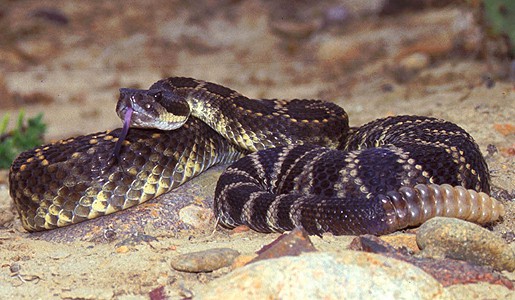
Southern Pacific Rattlesnake (Crotalus helleri)
Southern Pacific rattlesnakes grow 24 to 55 inches (61 to 140cm) long. Their base color is variable. They might be light brown, gray-brown, or yellowish-brown. Furthermore, they’re covered with a series of dark brown diamond-shaped blotches. At times, these blotches have light-colored centers. They have a dark diagonal stripe that extends from the bottom edge of their eye to the corner of their mouth. A pale stripe runs above the dark diagonal stripe above the eye. In older adults, the pale stripe darkens, and the head is a more uniform dark color.
Where Do Southern Pacific Rattlesnakes Live in California?
The Southern Pacific Rattlesnake lives in southern California. They also live in Baja California, Mexico.
How Dangerous Are Southern Pacific Rattlesnakes?
Southern Pacific Rattlesnake venom is a mixture of neurotoxins, hemotoxins, and myotoxins. A bite from one of these snakes has a multitude of potential symptoms. Some of them are pain, edema, metallic taste in the mouth, numbness, enlarged lymph nodes, and nausea. Severe envenomation can cause systemic complications. These include cardiovascular problems, internal bleeding, and kidney failure. Source
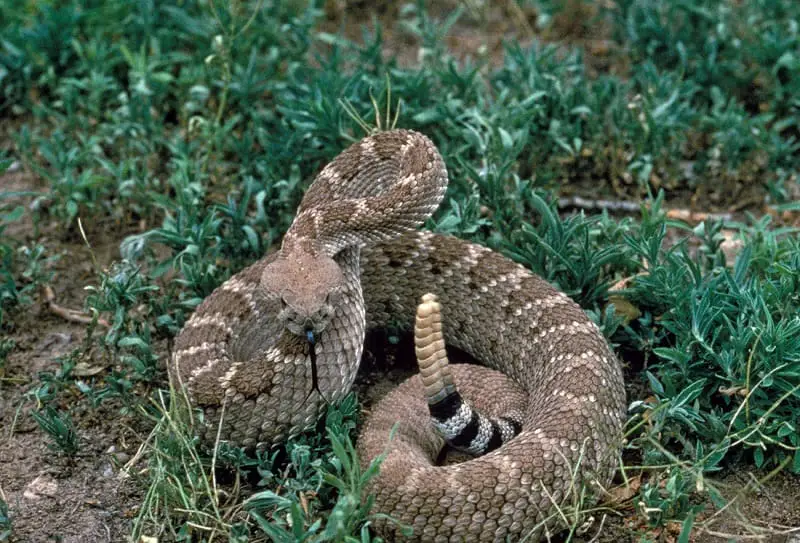
Western Diamondback Rattlesnake (Crotalus atrox)
The Western Diamondback is the largest of the southwestern desert rattlesnakes. They grow from 4 to 7 ft (1.22 to 2.13m) long. They have dark diamond-shaped patterns along their back. This is why they have the name “Diamondback.” A dark line runs from the corner of the mouth to behind the eye. Their base color varies from yellow, light brown, salmon, gray, gray-brown, cream, or olive. The edges of their dorsal spots are darker, with the centers slightly darker than the base color. Their tail has two to eight black bands separated by pale gray bands.
This species has various names, including the Western Diamond-backed rattlesnake and Adobe Snake.
Where Do Western Diamondback Rattlesnakes Live in California?
Western Diamondback Rattlesnakes live in San Bernardino, Riverside, and Imperial counties. This is in the southeastern part of the state.
How Dangerous Are Western Diamondback Rattlesnakes?
Western Diamondback rattlesnake venom is hemotoxic, cytotoxic, and myotoxic. If a Western Diamondback bite goes untreated, it can cause serious problems. These include severe internal bleeding and tissue damage, which might result in gangrene. Source
Venomous Colubrid Snakes
Colubrid snakes have grooved fangs at the back of their upper jaws and are rear-fanged. Most of them are not venomous, or their venom is not dangerous to humans.
The following are the venomous colubrids that are found in California.

Western Shovel-nosed Snake (Sonora occipitalis)
The Western Shovel-nosed snake is small at around 12 to 17 inches (30.48 to 43.18 cm) in length. Their snout is cream-colored. On top of the head, between and posterior to the eyes, is a black crescent moon shape. Their body is cream colored with blackish-brown bands. The majority have interspersed reddish-orange bands that don’t circle their body. The venom of the Western Shovel-nosed snake is not usually dangerous to humans.
These snakes live in desert regions with loose sandy soils. In California, they are found in the southern portion of the state.
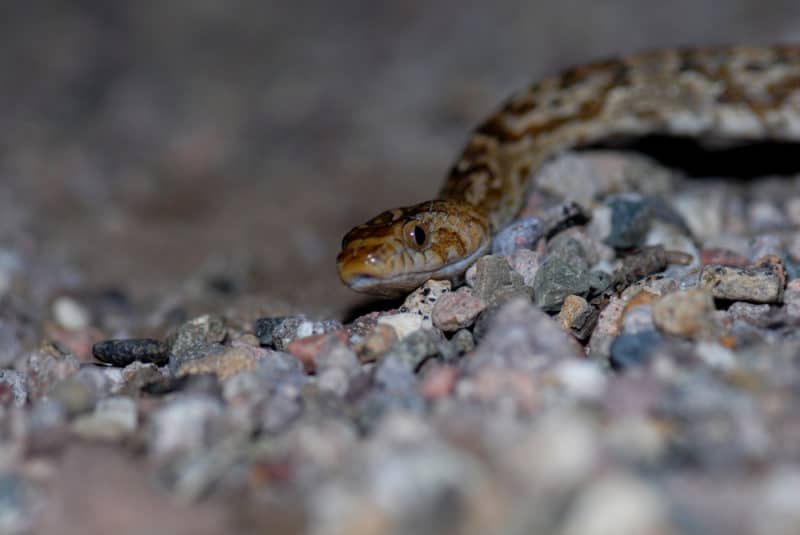
Sonoran Lyre Snake (Trimorphodon lambda)
The Sonoran Lyre snake is a thin snake that can get up to 4 feet (121.92cm) long. This snake gets its name from the markings on its head that resemble a lyre harp. This marking is more prominent in females. They have a light, brown-colored body with dark brown saddle markings. Their belly is a creamy white color scattered with brown spots. They look similar to a king snake until you notice the narrow neck, making its head appear triangular. Their pupils are vertical slits like other venomous snakes rather than round. They are rarely seen because they are nocturnal. This snake is mildly venomous but not considered dangerous.
These snakes live in southeastern California along the Colorado River.

Night Snake (Hypsiglena torquata)
The Night Snake is a rear-fanged, slightly venomous snake. It grows from 12 to 26 inches (30.48 to 66cm) long. This snake is a light beige to pale gray with dark gray or brown blotches on its sides and back. Its head is flat and triangular-shaped, with a dark brown bar behind its eyes. It also has a pair of dark blotches on the neck. Its belly is a whitish color.
The Night snake is slightly venomous but is no threat to humans.
California is home to three Night Snake sub-species. I’ll list them below.
- Desert Night Snake (Hypsiglena Chlorophaea deserticola)- Found in Imperial, Inyo, Kern, Lassen, Los Angeles, Modoc, Mono, Riverside, San Diego, and Siskiyou Counties.
- San Diego Night Snake (Hypsiglena ochrorhyncha klauberi)- Found in Los Angeles, Orange, Riverside, San Bernardino, San Diego, Santa Barbara, and Ventura counties. Also found on Santa Cruz Island.
- California Night Snake (Hypsiglena ochrorhyncha nuchalata)- Found in Alameda, Amador, Butte, Calaveras, Contra Costa, El Dorado, Fresno, Glenn, Kern, Kings, Lake, Madera, Mariposa, Merced, Monterey, Napa, Nevada, Placer, Plumas, Sacramento, San Benito, San Luis Obispo, San Mateo, Santa Barbara, Santa Clar, Shasta, Sierra, Solano, Sonoma, Stanislaus, Tehama, Trinity, Tulare, Tuolumne, Yolo, and Yuba counties.
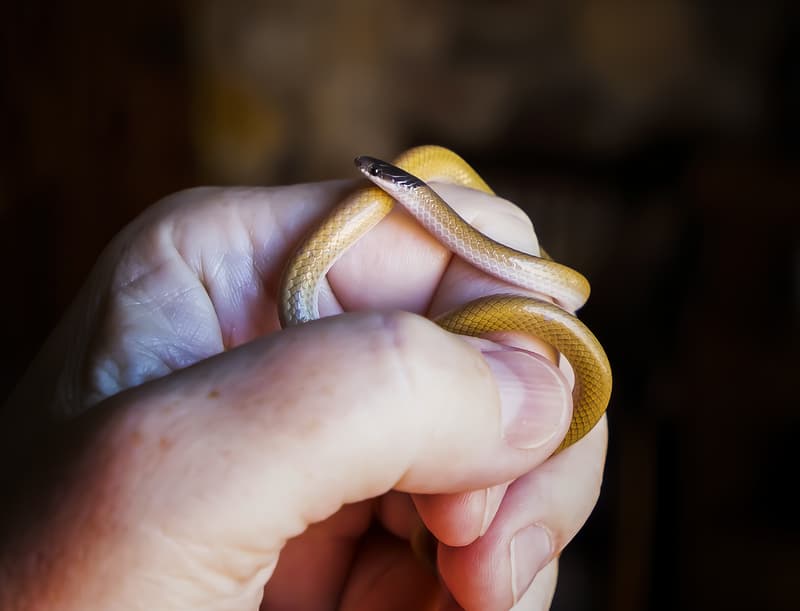
Southwestern Blackhead Snake (Tantilla hobartsmithi)
The Southwestern Blackhead is a tiny snake. Adults are 8 to 15 inches (20 to 38cm) long. The top of their body is brown in color with a blackhead. The belly is creamy white with a broad reddish stripe running down the center.
The western range of this snake begins in Baja California. It then extends north through California as far as San Fransico Bay.
Southwestern Blackhead snakes are nocturnal. They spend most of their time hiding in loose soil or underground debris. These are rear-fanged snakes whose venom is harmless to humans.
Symptoms of Venomous Snake Bites
Some of the symptoms you may experience from a venomous snake bite include:
- Discoloration in the area of the bite.
- Swelling in the area of the bite.
- Loss of muscle coordination.
- Tingling sensation in the area of the bite.
- Feeling nauseous.
- Having an abnormally rapid pulse.
What Should You Do If A Venomous Snake Bites You?
If you or someone you are with has suffered a venomous snakebite, time is of the essence. This is because the sooner a victim receives anti-venom, the less likely the venom in their body is to cause harm. In other words, it is important to seek immediate medical attention.
Do not attempt to kill the snake for identification purposes. This gives the snake a chance to bite you again. Also, consider that severed snakeheads can still bite and envenomate. If you have a phone, take a picture of the offending reptile. Otherwise, get started on your way to the doctor.
First Aid for Snake Bite Victims
- Remain calm and limit your movements. Do not run. If you must hike back to a vehicle, do it calmly and deliberately. Put as little stress on your heart as possible.
- Keep the area of the snake bite below the heart level and never above the heart level. Keeping the bite below the heart level will reduce the venom’s flow. However, holding the bite above your heart level will increase the venom’s flow.
- Remove all constricting items such as bracelets, watches, or rings before swelling occurs.
- Remember that using a cold compress on a venomous snake bite is not advisable. The cold may cause the local blood vessels to constrict and spread the venom faster.
- You can wash the affected area like any other wound with soap and water.
- You may cover the bite area with a moist dressing to reduce the swelling.
- Get medical attention as soon as possible. Call the hospital to tell them a venomous snake has bitten you. So they can have anti-venom ready to give you when you arrive.
- A person whom a venomous snake has bitten may go into shock. If this happens, lay them flat and cover them with a blanket.
Dressing for Snake Country
- High-top leather boots and long pants are both wise ideas.
- Also, wear loose-fitting denim. If there’s a gap before the snake’s fangs touch your skin, your chances of being envenomated are lower.
- In the absence of high-top leather boots, some people wear snake gaiters.
Recent Posts
The only venomous snakes in Washington State are Northern Pacific Rattlesnakes. The Northern Pacific Rattlesnake (Crotalus oreganus oreganus) is a sub-species of the Western Rattlesnake. Anyone...
Skunks are not classified as true hibernators. But they go into a state of torpor when the weather gets cold. Skunks are light sleep hibernators, along with opossums, bears, and raccoons. ...

